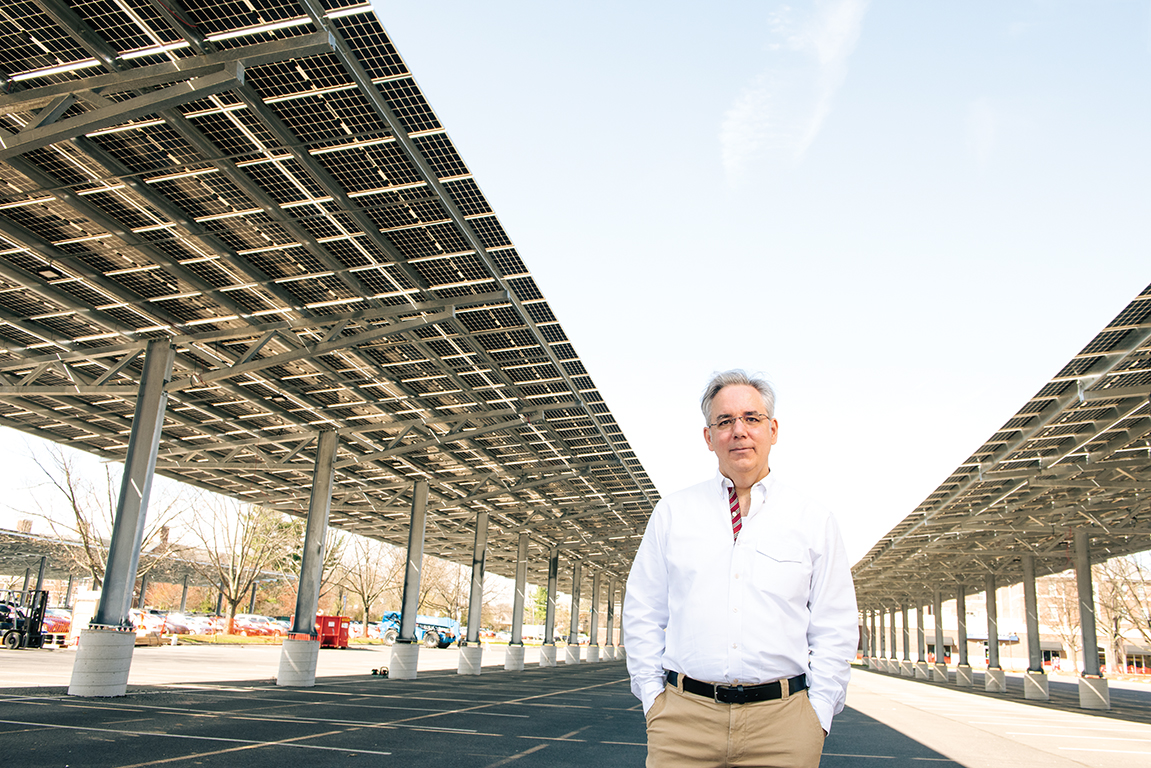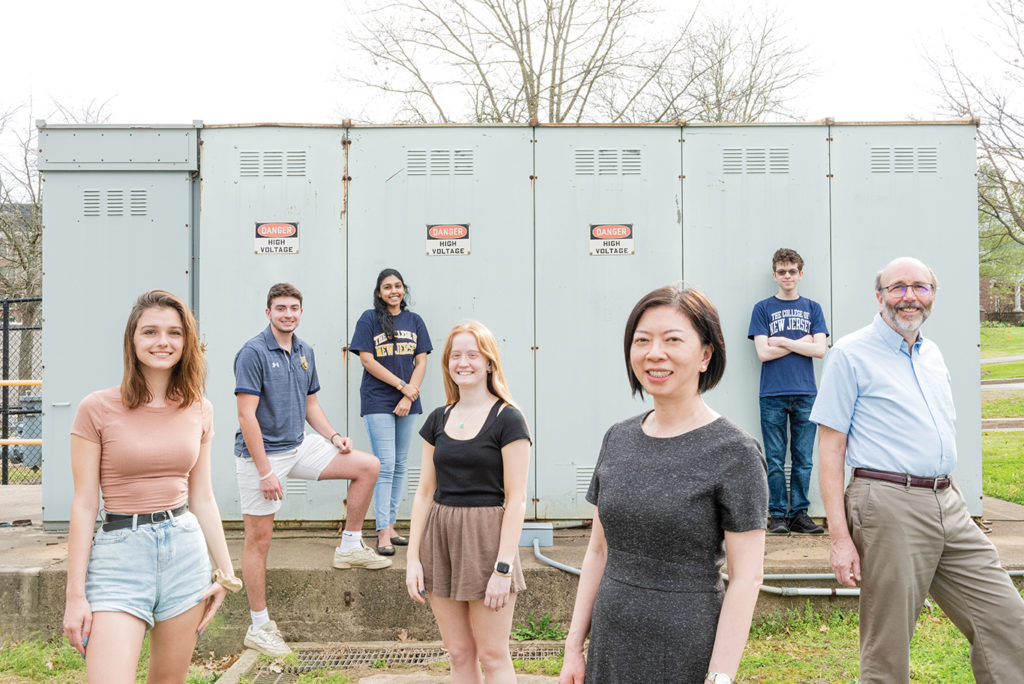Gauging the Grid
The college welcomes its first sustainability czar, and he hits the campus running. Paul Romano describes the evolution of his career in three chapters: his start as a conventional architect, his research conducted at the New Jersey Institute of Technology, and his efforts to reduce carbon emissions on behalf of Con Edison, the New York […]

Paul Romano, Senior Director of Sustainability and Energy Management at TCNJ.
The college welcomes its first sustainability czar, and he hits the campus running.
Paul Romano describes the evolution of his career in three chapters: his start as a conventional architect, his research conducted at the New Jersey Institute of Technology, and his efforts to reduce carbon emissions on behalf of Con Edison, the New York City energy supplier. He says his arrival on campus last fall, as The College of New Jersey’s first senior director of sustainability and energy management, represents an opportunity “to integrate those three chapters into a capstone of sorts.”
The TCNJ position appealed to Romano in large part because of the college’s commitment to achieve carbon neutrality by 2040, part of a national campaign among colleges and universities that TCNJ joined in 2007. “The college is much like a small city, with its own electric generation and utilities,” Romano says. “For me, it’s a fantastic opportunity to apply the diversity of my experience to this small city, to plan how we would attain carbon neutrality, to wean ourselves off of the fossil fuel systems we’re currently relying on.”
After six months on the job, and among multiple objectives, Romano is focused on three sustainability projects that reflect the college’s resolve to reduce its carbon footprint:
- a solar array project designed to reduce TCNJ’s energy costs;
- a landscaping initiative that calls for more native plantings across campus; and
- a collaborative venture, involving accounting students and computer science students, to examine environmentally benign ways to meet future energy needs.
“The college is a special place,” Romano says. “There are a lot of talented and ambitious folks, and they’re very eager to rise to the challenge of climate change and resiliency.”
The solar system
In the spring semester, TCNJ installed five solar arrays, a collection of solar panels designed to generate electricity. The panels exist on canopies over two parking lots, with more planned for the roofs of four buildings, including Brower Student Center. Below the parking lot canopies, TCNJ will install chargers for electric cars, a nod to the forward-looking nature of the college’s sustainability efforts. Referring to the college’s goal to decarbonize by 2040, Romano says TCNJ’s sustainability efforts could serve as a model for other institutions “by demonstrating practical solutions here on campus that may be employed elsewhere, what we refer to as ‘campus-as-lab.’”
Romano says the solar array system is expected to produce three megawatts of electricity — roughly half the peak electric demand campuswide — while reducing TCNJ’s annual energy costs by nearly $300,000. The college has entered into a 15-year agreement with a private solar energy developer to build and operate the solar arrays, which are expected to reduce annual carbon emissions by nearly two million tons. Because developers of solar energy projects benefit from federal tax credits and state regulatory incentives, Romano says, all the power produced by the solar arrays will be free to the college for the duration of the agreement.
Taking a look at landscaping
A new landscaping policy is designed to introduce more native plant species across the campus while reducing the use of pesticides and fertilizers. The policy came about through an alliance of TCNJ professors, students, alumni, and staff and with guidance from the Environmental Sustainability Council. Miriam Shakow, a professor of anthropology, says the policy will increase the biodiversity of pollinators on campus.
“Somewhere around 30% of food requires pollination,” Shakow says. “To support pollinators, you need native plants.”
Hannah Beckett ’23, a self-designed major in environmental sustainability, helped to draft the new landscaping plan. She says the policy sets forth a series of “larger goals and ideas.” Among the policy’s objectives: reducing carbon emissions by vehicles used for landscape maintenance; lowering the cost of maintenance in part by reducing the use of chemicals and labor; and using native plants in 90% of the new plantings on campus by 2024.
Meanwhile, a student group, People4Plants, organized a day of planting in April by Green Hall. The group’s president, Angela Mo ’23, a biology major, says People4Plants is focused on creating spaces that will become ecologically active. “The plants we put in our gardens will hopefully provide habitats for beneficial insects and increase biodiversity on campus, even on a small scale,” Mo says. “We are also looking to plant rain gardens, which are a type of garden that is specifically designed to absorb water. We are hoping that by planting rain gardens across campus, it will limit the amount of mulch that sometimes muddies the paths on rainy days.”

An energy exam
What do you get when you cross a class of accounting students with a class of computer science students? In the case of Bih-Horng Chiang’s and John DeGood’s classes, you get a National Science Foundation-funded examination of the energy supply and demand on the TCNJ campus, including the college’s vehicle fleet.
This spring, Chiang’s and DeGood’s students — nearly 100 in all — with additional direction from Romano, met regularly to determine the most financially and environmentally efficient ways to manage TCNJ’s current and future energy use. Chiang says her accounting students benefited by stepping out of their comfort zone to work side by side with DeGood’s computer science students. “The process of completing this cross discipline collaboration project allowed students to apply accounting principles in a practical way and exercise their critical thinking and communication skills,” she says.
Working with Romano, Chiang says, her students “developed a deeper sense of campus sustainability and a more tangible idea of the efficiency of campus energy and vehicle utilization.”
The students built databases that included 1,400 data points taken from electric meter readings across campus and historical temperature information provided by the National Weather Service. “We really challenged the students,” DeGood says. “We gave them this problem in a very open-ended fashion, and we asked them to pose the right questions.”
For Romano, the students’ work — cost accounting, database development — has been central to informing TCNJ’s energy strategy. “They’re helping the college assess our environmental and financial impact,” he says.
Pictures: Peter Murphy
Posted on May 26, 2022

